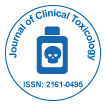
Journal of Clinical Toxicology
Open Access
ISSN: 2161-0495

ISSN: 2161-0495
Opinion - (2025)Volume 15, Issue 2
Ocular toxicology, a specialized branch of toxicology focusing on the adverse effects of chemicals and drugs on the eye, has long been an underappreciated yet critically important field. Given that vision is one of our most vital senses, the eyeâs vulnerability to toxic substances whether through direct exposure or systemic absorption poses a significant threat to individual health and quality of life. As the world increasingly relies on synthetic chemicals in industry, agriculture, medicine and consumer products, there is a pressing need to recognize and respond to the potential ocular hazards associated with these substances.
The eye is uniquely sensitive due to its anatomical and physiological features. Its exposure to the external environment, rich vascular supply and highly specialized tissues such as the cornea, retina, and optic nerve make it both a target and a window for systemic toxicity. Substances can reach ocular tissues through direct contact (e.g., splashes of industrial chemicals) or via systemic circulation following ingestion or inhalation. Common toxic agents include solvents, heavy metals, detergents and certain pharmaceutical drugs, many of which can lead to irreversible damage if not promptly recognized and managed.
From my perspective, ocular toxicology deserves far more attention than it currently receives in both clinical and regulatory settings. For example, routine ocular toxicity assessments during drug development are often limited, with emphasis placed more on systemic or dermal toxicities. Yet numerous medications from antimalarials like chloroquine to cancer therapies and even some antibiotics carry well-documented risks of ocular side effects, including blurred vision, retinal toxicity and optic neuritis. These adverse effects can drastically reduce quality of life, especially if the risk goes unmonitored in vulnerable populations.
Occupational exposure represents another major area of concern. Workers in industries such as manufacturing, mining, chemical production and healthcare may be exposed to eye irritants or corrosive substances daily. Even low-level chronic exposure can result in cumulative ocular damage. The lack of protective equipment, poor ventilation and inadequate safety training exacerbate the risk. In agricultural settings, exposure to pesticides has been associated with both acute and long-term ocular issues, ranging from conjunctivitis to retinal degeneration. The enforcement of stricter workplace safety standards, mandatory eye protection and employee education should be considered non-negotiable components of occupational health.
The increasing use of digital devices also introduces a more modern and subtle form of ocular stress. Although not toxic in the traditional chemical sense, prolonged screen exposure is associated with digital eye strain, dry eye syndrome and potential retinal effects from high-energy visible light. These emerging issues signal the need to broaden our understanding of ocular "toxicity" beyond classic chemical exposure.
The path forward involves three main strategies. First, more comprehensive ocular toxicity testing should be mandated in pharmaceutical and chemical safety evaluations. Second, public and occupational health policies must prioritize eye safety with preventive interventions, including stricter labeling, protective gear and regular ocular screenings for at-risk populations. Third, public awareness campaigns are needed to educate individuals about the potential ocular risks associated with both environmental exposures and personal behaviors.
In conclusion, ocular toxicology is not merely an academic concern it is a public health necessity. With vision so central to our daily function and wellbeing, neglecting the toxicological safety of the eyes is a shortcoming we can no longer afford. By elevating this discipline within toxicology and health policy, we can safeguard not just sight, but the broader quality of life for millions across the globe.
Citation: Mensah DT (2025). Safeguarding Vision through Ocular Toxicology Awareness. J Clin Toxicol. 15:592.
Received: 03-Mar-2025, Manuscript No. JCT-25-37527; Editor assigned: 06-Mar-2025, Pre QC No. JCT-25-37527 (PQ); Reviewed: 20-Mar-2025, QC No. JCT-25-37527; Revised: 27-Mar-2025, Manuscript No. JCT-25-37527 (R); Published: 07-Apr-2025 , DOI: 10.35248/2475-3181.25.15.592
Copyright: © 2025 Mensah DT. This is an open-access article distributed under the terms of the Creative Commons Attribution License, which permits unrestricted use, distribution, and reproduction in any medium, provided the original author and source are credited.